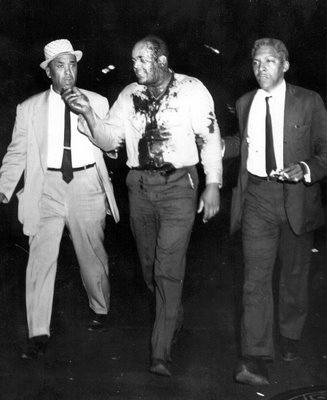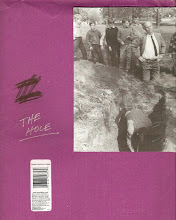
“*Come Out* was originally part of a benefit concert presented at Town Hall in New York City for the retrial, with lawyers of their own choosing, of the six boys arrested for murder during the Harlem riots of 1964. The voice is that of Daniel Hamm, now acquitted and then 19, describing a beating he took in Harlem’s 28th precinct police station. The police were about to take the boys out to be ‘cleaned up’ and were only taking those that were visibly bleeding. Since Hamm had no actual open bleeding, he proceeded to open a bruise on his leg so that he would be taken to the hospital. ‘I had to like open the bruise up and let some of the bruised blood come out to show them.’
“*Come Out* is composed of a single loop recorded on both channels. First the loop is in unison with itself. As it begins to go out of phase, a slowly increasing reverberation is heard. This gradually passes into a canon or round for two voices, then four voices and finally eight."
--Steve Reich
Reich's "tape piece," *Come Out*, is of a moment in the composer's career when he was experimenting with tape loops to create aural-acoustic effects similar to those of Medieval 13th century round and chant. The primary technical means of achieving these effects was through tape "phasing". To achieve phasing, Reich made copies of sound loops and synchronized the copies among different audio channels. As his tracks were not perfectly synchronized, loops that would begin in-synch would eventually come out-of-synch, *phasing* them. Through Reich’s discovery of phase composition he was led to the major contributions of his career: his explorations of “gradual” or “serialist” forms, polyrhythmic subtraction, and the rhythms and intonations of speech.
The radicality of Reich’s work with tape phasing (*It's Going To Rain* and *Come Out*) and many of his subsequent compositions, lies in an aural-cognitive process. When one listens to *Come Out* for the first time (if not many times after), one is likely struck by a shift about two minutes into the piece when one first hears the loops begin to desynch. During this moment, one hears the loops separating physically, concretely, in their “head-space,” as well as in their body. As Reich himself describes his first encounter with tape phasing: “The sensation I had in my head was that the sound moved over to my left ear, down to my left shoulder, down my left arm, down my leg, out across the floor to the left, and finally began to reverberate and shake and become the sound that I was looking for--‘It’s gonna / It’s gonna rain / rain’--and then it started going the other way and came back together in the center of my head. When I heard that, I realized it was more interesting than any one particular relationship, because it was the process (of gradually passing through all canonic relationships) making an entire piece, and not just a moment in time.(*WoM*, 21)" In Steve Reich's "Come Out," as in "It's Going To Rain," one hears and feels the tracks separate and then there is kind of leap, a skipping-of-tracks where the tracks cleave each other at a point where they are no longer synched, but also not sufficiently unsynched to allow a listener to hold both tracks in their attention simultaneously. The effect is what the American poet, Emily Dickinson, likely experienced as a “cleaving in the mind” and what the French philosopher, Maurice Merleau-Ponty, dubbed “chiasmic” in his late philosophical papers. As the phases cross in one’s attention, they briefly produce a kind of blank or aural blind-spot constitutive of a cognitive non-sense.
It is during this cognitive-acoustic event that I believe psychological processes pass over into problems of ontology. The chiasmic event of Reich's *Come Out* manifests a verticality interrupting the accretive horizontality of the tape loop. This coming *out* which interrupts and also comes *in*--‘outwards (or inwards) towards it’[1]--seems appropriate to the work’s demanding content: the police misconduct and institutional racism made blatant during the 1964 Harlem riots. If the tape loops create a recurrent horizon of sound--one long, serialized note not yet apparent in its multi-channel stereophony--the phase event which occurs two minutes into the piece performs a transcendent operation within the immanence of a continuous psycho-acoustic horizon. Where this horizontality of sound can be said to form an acoustical "dwelling place" for the listener's attentions, the interrupting phase event evidences a breaking of exteriority upon that dwelling. By this interruption emerges an ecstatic, if not anarchic, interval of the listening-mind (the term "anarchy" originating from the Greek *anarche*: that which lacks beginning, time, or sequence).
The radical exteriority of the formal event of phase shift in *Come Out* is a necessary aesthethic response to the demands of *Come Out*’s exigent content. The full recorded phrase of Hamm’s speech from which Reich makes his loops, and which he plays in full at the outset of the work--"I had to like open the bruise up and let some of the bruised blood come out to show them"--in its traumatic syntax and deictical indeterminacy, immediately puts *Come Out’s* listener in a position to puzzle the phrase’s alarming referent: a wound the teenager has suffered at the hands of the police. Address is crucial for this interruptive movement, as the listener-addressee of Reich's piece hears-out the recorded speech of one calling to another to attend (and thus bears witnesss to) his suffering. As Hamm announces the opening of his wound, the “bruised blood” of the tape loop, in order that it may be attended to physically by medics and legally by eyewitnesses, the wound becomes a physical site where interior and exterior are volatized by their ambivalence. Evidencing the ambiguous status of his bruise, Hamm's speech may articulate an exceptional or indiscernible point[2] beyond the law, as the law fails to result in justice during the Harlem riots and in the particular cases of Hamm and the other teenagers absued and mischarged by police.
The chiasmic sound event of *Come Out* we may imagine alongside the famous scene of police brutality and retribution from one of the most famous films to first take up the failures of the Civil Rights movement (and 60's social movements in general), and which inaugurates the independent film movement known as Blaxploitation: Mario Van Peebles 1970 film, *Sweet Sweetback’s Badassss Song*. In this scene the protagonist Sweetback (played by Peebles) must make a decision whether or not to rescue a young Black Panther from two police officers who are beating him to death. Sweetback, a hero typical of Blaxploitation cinema in his ardent individualism and ability to "play all sides," reluctantly intervenes in the beating, maiming both of the police officers and thus abandoning his favor with the law (in the scene, Sweetback has consented to be arrested in order to fulfill an arrest quota). What is most striking about this scene is the way it gives form to a complex ethics of violence. After the scene's complexities, I am reminded of Walter Benjamin’s own “Critique of Violence” in its call for a “pure violence” that, in Giorgio Agamben’s reading of Benjamin’s essay, plays in a suspension between social law and animal force (what Agamben calls the “bare life” of "sovereign" man):
"What can this other type of relation to an end be? It will be useful to apply the considerations that we have just developed concerning the meaning of Benjamin’s term 'pure' to the concept 'pure medium' as well. The medium does not owe its purity to any specific intrinsic property that differentiates it from juridical means, but to its relation to them. In the essay on language, pure language is that which is not an instrument for the purpose of communication, but communicates itself immediately, that is, a pure and simple communicability; likewise, pure violence is that which does not stand in relation of means toward an end, but holds itself in relation to its own mediality. And just as pure language is not another language, just as it does not have a place other than that of the natural communicative languages, but reveals itself in these by exposing them as such, so pure violence is attested to only as the exposure and deposition of the relation between violence and law. (*State of Exception*, 62)"
Benjamin’s pure violence is “pure” not in the sense of an ideal form, so much as after the way Nietzsche imagined his “will to power” as a dance within a force-field of fatal values. To play here means that one no longer acts out of preparation or with a clear sense of purpose (*telos*), but instead within a circumstance in which clear moral-legal imperatives would seem altogether lacking. The close-ups of body parts and medium shots of the figures of Sweetback, the teenager, and the two police officers against a background that would be utterly dark if not for two oil-drills somnolently pumping, also instances what Emmanuel Levinas called the *Il y a* (“there is”): the dark night of creation antedating social law, in which existents struggle for expression, substituting for each other in preliminary reponsibilties:
“Essence stretching on indefinitely, without any possible halt or interruption, the equality of essence not justifying, in all equality, any instant’s halt, without respite, without any possible suspension, is the horrifying *there is* behind all finality proper to the thematizing ego, which can not sink into the essence it thematizes. It is inasmuch as the signification of the one-for-the-other is thematized and assembled, and through the simultaneity of essence, that the one is posited as an ego, that is, as a present or as a beginning or as free, as a subject facing an object. But it is also posited as belonging to essence, which when assembled cannot leave anything outside, has no outside, cannot be worn away. This way for the subject to find itself again in essence, whereas essence, as assembled, should have made possible the present and freedom, is not harmonious and inoffensive participation. It is the incessant buzzing that fills each silence, where the subject detaches itself as a subject in face of its objectivity. A rumbling intolerable to a subject that faces itself as a subject, and assembles essence before itself as an object. But its own subtraction is unjustifiable in an equal woven fabric, of absolute equity. The rumbling of the *there is* is the non-sense in which essence turns, and in which thus turns the justice issued out of signification.”(*Otherwise Than Being*, 163)
The dark discourseless night of the *Il y a*, a night of animal cries and affective speech held in communicative abeyance, holds all of the terror of Sweetback’s ethical decision, as well as our own struggles as viewers to bear witness to this scene of discomforting violence. In its shadeful deictics, a chiasmic index demanding social action and ethical responsibility towards another, I believe the phase event of *Come Out* to similarly instance the “there is”. Through the phase event of “Come / Come out / out to show them,” Come Out produces a duration both arriving and departing when we would listen with others to a terrifying speech of testimony more affective than signification alone, more imperative than the laws of *polis*. In the shadeful sensibility of this moment we would also heed a call to come out the redoubling of an actual blood: to see, to listen, to point to a body in pain pointing; to point again to what will not be entirely located, sited, or sighted; to eventually tell.
1. Taggart, John. *Songs of Degrees*. Tuscaloosa: The University of Alabama Press, 1994.
2. see Giorgio Agamben's concepts of the "state of exception" and "points of indiscernibility" throughout his books *Homo Sacer* and *State of Exception*.
"Come Out" was originally composed as a companion essay to one on Gordon Matta-Clark's *Splitting* (now out in Sarah Campbell's gorgeous P-Queue!!!).












No comments:
Post a Comment